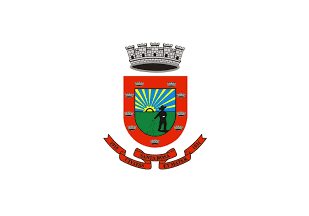 image by Ivan Sache, 4 August 2020
image by Ivan Sache, 4 August 2020
Last modified: 2020-08-08 by ian macdonald
Keywords: rio grande do sul | santa rosa |
Links: FOTW homepage |
search |
disclaimer and copyright |
write us |
mirrors
 image by Ivan Sache, 4 August 2020
image by Ivan Sache, 4 August 2020
The municipality of Santa Rosa (72,504 inhabitants in 2016; 48,980 ha) is
located 500 km north-west of Porto Alegre.
Santa Rosa was established in
1876 as a district of Santo Ângelo, whose colonization was initiated in 1915
with the set up of plots. The colony grew quickly to 11,215 inhabitants in 1920.
Pushed by the newspaper "A Serra" set up by the emancipation movement, the
municipality of Santa Rosa was established on 1 July 1931 and inaugurated on 10
August 1931. The railway connecting Santa Rosa to Santo Ângelo was inaugurated
on 12 May 1940.
https://www.santarosa.rs.gov.br/
Municipal website
Ivan Sache, 4 August 2020
A white flag with the
municipal arms in the centre.
Dirk Schönberger,
23 March 2012
Santa Rosa is the birth town of Cláudio Taffarel (b. 1966), goalkeeper of the
Brazil national team (101 caps), winner of the 1994 FIFA World Cup and runner-up
of the 1998 FIFA World Cup. During his European career, Taffarel won the UEFA
Winners' Cup 1992-1993 with Parma and the UEFA Cup 1999-2000 with Galatasaray.
The coat of arms of Santa Rosa is prescribed by Municipal Law no. 754
promulgated on 18 May 1966, which is incorporated into Municipal Law No. 4,506
promulgated on 23 April 2009.
Article 2.
The coat of arms, adopted as
symbol of the municipality of Santa Rosa by Law No. 754 promulgated on 18 May
1966, has the following heraldic description:
A Portuguese shield. Field
divided per fess blue and green, a cogwheel-shaped rising sun and a sowing
farmer; a red border charged with nine small mural crowns argent; a five-towered
mural crown argent, a red scroll charged with the municipality's name argent,
with the honorific title it was awarded, also argent, and dates "1915" and
"1931".
Article 3.
The colors used in the coat of arms are those of
Rio Grande do Sul (green, yellow and red) and Brazil (green, yellow and blue).
The cogwheel-shaped rising sun means emerging industry while the sowing farmer
represents the origin of all the municipality's income. The nine small mural
crowns in the red border represent the nine towns that formed the old
municipality of Santa Rosa. On the scroll are featured the municipality's name,
the honorific title it was awarded, and the dates "1915", as the onset of
colonization, and "1931", as political emancipation. The mural crown indicates
the rank of municipal seat.
Article 11.
The town of Santa Rosa is
awarded the title of "CIVITAS ET MATER", which means "Town and Mother", for
having originated in a short time span a great number of towns.
Article
12.
This title shall be featured on the coat of arms adopted as the municipal
symbol.
https://leismunicipais.com.br/a/rs/s/santa-rosa/lei-ordinaria/2009/451/4506/lei-ordinaria-n-4506-2009-dispoe-sobre-os-simbolos-do-municipio-de-santa-rosa-consolidando-a-legislacao-respectiva
Leis Municipais database
Photos
https://www.facebook.com/PrefeituraMunicipalDeSantaRosaRS/photos
https://www.facebook.com/PrefeituraMunicipalDeSantaRosaRS/photos
https://www.facebook.com/PrefeituraMunicipalDeSantaRosaRS/photos
https://www.facebook.com/PrefeituraMunicipalDeSantaRosaRS/photos
Ivan Sache, 4 August 2020